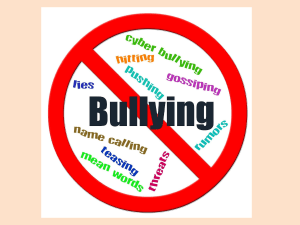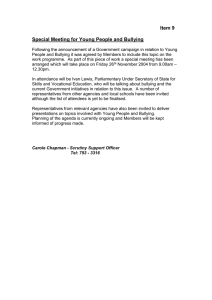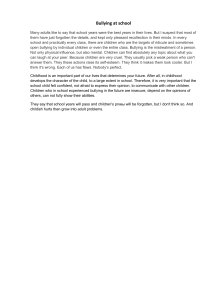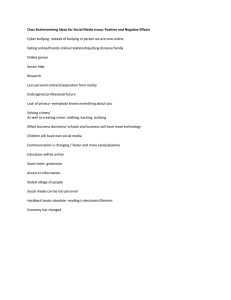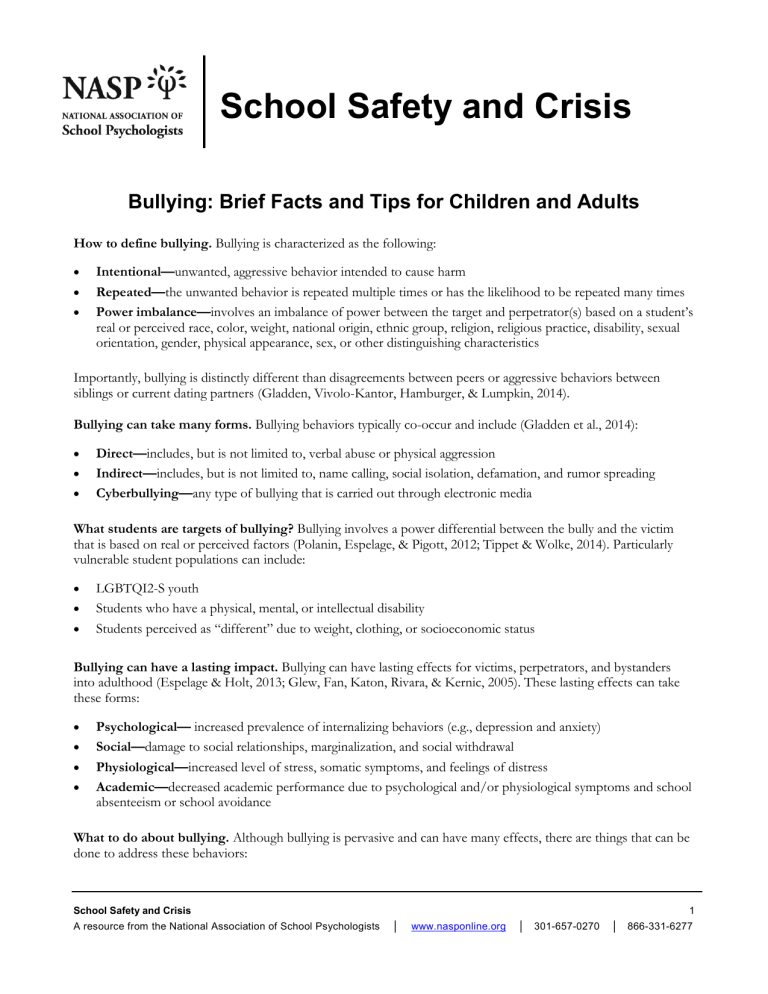
School Safety and Crisis Bullying: Brief Facts and Tips for Children and Adults How to define bullying. Bullying is characterized as the following: • • • Intentional—unwanted, aggressive behavior intended to cause harm Repeated—the unwanted behavior is repeated multiple times or has the likelihood to be repeated many times Power imbalance—involves an imbalance of power between the target and perpetrator(s) based on a student’s real or perceived race, color, weight, national origin, ethnic group, religion, religious practice, disability, sexual orientation, gender, physical appearance, sex, or other distinguishing characteristics Importantly, bullying is distinctly different than disagreements between peers or aggressive behaviors between siblings or current dating partners (Gladden, Vivolo-Kantor, Hamburger, & Lumpkin, 2014). Bullying can take many forms. Bullying behaviors typically co-occur and include (Gladden et al., 2014): • • • Direct—includes, but is not limited to, verbal abuse or physical aggression Indirect—includes, but is not limited to, name calling, social isolation, defamation, and rumor spreading Cyberbullying—any type of bullying that is carried out through electronic media What students are targets of bullying? Bullying involves a power differential between the bully and the victim that is based on real or perceived factors (Polanin, Espelage, & Pigott, 2012; Tippet & Wolke, 2014). Particularly vulnerable student populations can include: • • • LGBTQI2-S youth Students who have a physical, mental, or intellectual disability Students perceived as “different” due to weight, clothing, or socioeconomic status Bullying can have a lasting impact. Bullying can have lasting effects for victims, perpetrators, and bystanders into adulthood (Espelage & Holt, 2013; Glew, Fan, Katon, Rivara, & Kernic, 2005). These lasting effects can take these forms: • • • • Psychological— increased prevalence of internalizing behaviors (e.g., depression and anxiety) Social—damage to social relationships, marginalization, and social withdrawal Physiological—increased level of stress, somatic symptoms, and feelings of distress Academic—decreased academic performance due to psychological and/or physiological symptoms and school absenteeism or school avoidance What to do about bullying. Although bullying is pervasive and can have many effects, there are things that can be done to address these behaviors: School Safety and Crisis A resource from the National Association of School Psychologists 1 │ www.nasponline.org │ 301-657-0270 │ 866-331-6277 Bullying: Brief Facts and Tips for Children and Adults • • For adults: ▪ Model and teach respectful behavior systematically. ▪ Develop, implement, and enforce antibullying policies. ▪ Recognize bullying as a mental health and relationship issue. ▪ Use a comprehensive approach to address bullying. ▪ Teach responsible use of technology. ▪ Provide support to students who may be marginalized (e.g., LGBTQI2-S, religious minorities, students with disabilities). ▪ Address bullying with bystanders and stress importance and responsibility to stop harassment and intimidation. For youth: ▪ Report instances of bullying to adults. ▪ Stand up to bullying if the situation is safe. ▪ Show kindness to ALL students. ▪ Reach out to students who are being bullied. ADDITIONAL RESOURCES • • • • • • • Bullying Resources from the National Association of School Psychologists, https://www.nasponline.org/bullying-prevention Bullying Prevention and Intervention Information and Resources, https://www.stopbullying.gov Cyberbullying Research Center, https://cyberbullying.org Pacer’s National Bullying Prevention Center, https://www.pacer.org/bullying/ Resources for addressing the five competencies for social and emotional learning, https://casel.org UB Alberti Center for Bullying Abuse Prevention, http://ed.buffalo.edu/alberti.html National Suicide Prevention Lifeline, 1-800-273-8255 REFERENCES Espelage, D. L., & Holt, M. K. (2013). Suicidal ideation and school bullying experiences after controlling for depression and delinquency. Journal of Adolescent Health, 53, S27–S31. doi:10.1016/j.jadohealth.2012.09.017 Gladden, R. M., Vivolo-Kantor, A. M., Hamburger, M. E., & Lumpkin, C. D. (2014). Bullying surveillance among youth: Uniform definitions for public health and recommended data elements, version 1.0. Atlanta, GA: National Center for Injury Prevention and Control, Centers for Disease Control and Prevention and U.S. Department of Education. Glew, G. M., Fan, M., Katon, W. J., Rivara, F. P., & Kernic, M. A. (2005). Bullying, psychosocial adjustment, and academic performance in elementary school. Archives of Pediatric and Adolescent Medicine, 159, 1026–1031. doi:10.1001/archpedi.159.11.1026 Polanin, J. R., Espelage, D. L., & Pigott, T. D. (2012). A meta-analysis of school-based bulling prevention programs’ effects on bystander intervention behavior. School Psychology Review, 41, 47–65. Tippet, N., & Wolke, D. (2014). Socioeconomic status and bullying: A meta-analysis. American Journal of Public Health, 104(6). 4–59. doi:10.2105/ajph.2014.301960 © 2019, National Association of School Psychologists, 4340 East West Highway, Suite 402, Bethesda, MD 20814, 301-657-0270, www.nasponline.org School Safety and Crisis A resource from the National Association of School Psychologists 2 │ www.nasponline.org │ 301-657-0270 │ 866-331-6277


